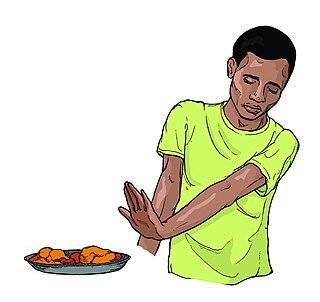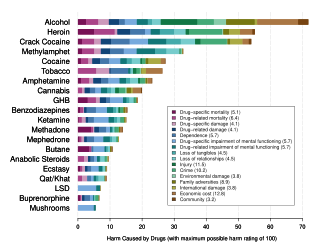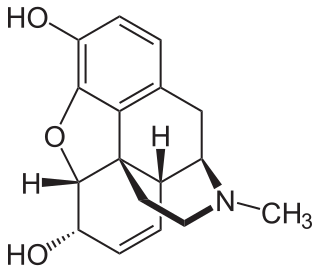Related Research Articles

Anorexia is a medical term for a loss of appetite. While the term outside of the scientific literature is often used interchangeably with anorexia nervosa, many possible causes exist for a loss of appetite, some of which may be harmless, while others indicate a serious clinical condition or pose a significant risk.

Psychopharmacology is the scientific study of the effects drugs have on mood, sensation, thinking, behavior, judgment and evaluation, and memory. It is distinguished from neuropsychopharmacology, which emphasizes the correlation between drug-induced changes in the functioning of cells in the nervous system and changes in consciousness and behavior.

Substance abuse, also known as drug abuse, is the use of a drug in amounts or by methods that are harmful to the individual or others. It is a form of substance-related disorder. Differing definitions of drug abuse are used in public health, medical, and criminal justice contexts. In some cases, criminal or anti-social behavior occurs when the person is under the influence of a drug, and long-term personality changes in individuals may also occur. In addition to possible physical, social, and psychological harm, the use of some drugs may also lead to criminal penalties, although these vary widely depending on the local jurisdiction.
"these disease are derived from variables such as genetics, biological, socio-cultural, systematic, and biopsychosocial factors"

Drug rehabilitation is the process of medical or psychotherapeutic treatment for dependency on psychoactive substances such as alcohol, prescription drugs, and street drugs such as cannabis, cocaine, heroin or amphetamines. The general intent is to enable the patient to confront substance dependence, if present, and stop substance misuse to avoid the psychological, legal, financial, social, and physical consequences that can be caused.Citation needed
Self-medication, sometime called do-it-yourself (DIY) medicine, is a human behavior in which an individual uses a substance or any exogenous influence to self-administer treatment for physical or psychological conditions, for example headaches or fatigue.
A paradoxical reaction is an effect of a chemical substance, such as a medical drug, that is opposite to what would usually be expected. An example of a paradoxical reaction is pain caused by a pain relief medication.

Opioid use disorder (OUD) is a substance use disorder characterized by cravings for opioids, continued use despite physical and/or psychological deterioration, increased tolerance with use, and withdrawal symptoms after discontinuing opioids. Opioid withdrawal symptoms include nausea, muscle aches, diarrhea, trouble sleeping, agitation, and a low mood. Addiction and dependence are important components of opioid use disorder.
Drugs and prostitution have been documented to have a direct correlation.
Psychomotor agitation is a symptom in various disorders and health conditions. It is characterized by unintentional and purposeless motions and restlessness, often but not always accompanied by emotional distress. Typical manifestations include pacing around, wringing of the hands, uncontrolled tongue movement, pulling off clothing and putting it back on, and other similar actions. In more severe cases, the motions may become harmful to the individual, and may involve things such as ripping, tearing, or chewing at the skin around one's fingernails, lips, or other body parts to the point of bleeding. Psychomotor agitation is typically found in various mental disorders, especially in psychotic and mood disorders. It can be a result of drug intoxication or withdrawal. It can also be caused by severe hyponatremia. The middle-aged and the elderly are more at risk to express it.
Substance dependence, also known as drug dependence, is a biopsychological situation whereby an individual's functionality is dependent on the necessitated re-consumption of a psychoactive substance because of an adaptive state that has developed within the individual from psychoactive substance consumption that results in the experience of withdrawal and that necessitates the re-consumption of the drug. A drug addiction, a distinct concept from substance dependence, is defined as compulsive, out-of-control drug use, despite negative consequences. An addictive drug is a drug which is both rewarding and reinforcing. ΔFosB, a gene transcription factor, is now known to be a critical component and common factor in the development of virtually all forms of behavioral and drug addictions, but not dependence.
Child psychopathology refers to the scientific study of mental disorders in children and adolescents. Oppositional defiant disorder, attention-deficit hyperactivity disorder, and autism spectrum disorder are examples of psychopathology that are typically first diagnosed during childhood. Mental health providers who work with children and adolescents are informed by research in developmental psychology, clinical child psychology, and family systems. Lists of child and adult mental disorders can be found in the International Statistical Classification of Diseases and Related Health Problems, 10th Edition (ICD-10), published by the World Health Organization (WHO) and in the Diagnostic and Statistical Manual of Mental Disorders, Fifth Edition (DSM-5), published by the American Psychiatric Association (APA). In addition, the Diagnostic Classification of Mental Health and Developmental Disorders of Infancy and Early Childhood is used in assessing mental health and developmental disorders in children up to age five.

Despite the scientifically well-established nature of attention deficit hyperactivity disorder (ADHD), its diagnosis, and its treatment, each of these has been controversial since the 1970s. The controversies involve clinicians, teachers, policymakers, parents, and the media. Positions range from the view that ADHD is within the normal range of behavior to the hypothesis that ADHD is a genetic condition. Other areas of controversy include the use of stimulant medications in children, the method of diagnosis, and the possibility of overdiagnosis. In 2009, the National Institute for Health and Care Excellence, while acknowledging the controversy, stated that the current treatments and methods of diagnosis are based on the dominant view of the academic literature.
Mental disorders are classified as a psychological condition marked primarily by sufficient disorganization of personality, mind, and emotions to seriously impair the normal psychological and often social functioning of the individual. Individuals diagnosed with certain mental disorders can be unable to function normally in society. Mental disorders may consist of several affective, behavioral, cognitive and perceptual components. The acknowledgement and understanding of mental health conditions has changed over time and across cultures. There are still variations in the definition, classification, and treatment of mental disorders.
Sex and drugs date back to ancient humans and have been interlocked throughout human history. Both legal and illegal, the consumption of drugs and their effects on the human body encompasses all aspects of sex, including desire, performance, pleasure, conception, gestation, and disease.
Attention deficit hyperactivity disorder management options are evidence-based practices with established treatment efficacy for ADHD.
Dual diagnosis is the condition of having a mental illness and a comorbid substance use disorder. There is considerable debate surrounding the appropriateness of using a single category for a heterogeneous group of individuals with complex needs and a varied range of problems. The concept can be used broadly, for example depression and alcohol use disorder, or it can be restricted to specify severe mental illness and substance use disorder, or a person who has a milder mental illness and a drug dependency, such as panic disorder or generalized anxiety disorder and is dependent on opioids. Diagnosing a primary psychiatric illness in people who use substances is challenging as substance use disorder itself often induces psychiatric symptoms, thus making it necessary to differentiate between substance induced and pre-existing mental illness.

Polysubstance dependence refers to a type of substance use disorder in which an individual uses at least three different classes of substances indiscriminately and does not have a favorite substance that qualifies for dependence on its own. Although any combination of three substances can be used, studies have shown that alcohol is commonly used with another substance. This is supported by one study on polysubstance use that separated participants who used multiple substances into groups based on their preferred substance. The results of a longitudinal study on substance use led the researchers to observe that excessively using or relying on one substance increased the probability of excessively using or relying on another substance.

Substance use disorder (SUD) is the persistent use of drugs despite the substantial harm and adverse consequences to one's own self and others, as a result of their use. In perspective, the effects of the wrong use of substances that are capable of causing harm to the user or others, have been extensively described in different studies using a variety of terms such as substance use problems, problematic drugs or alcohol use, and substance use disorder. The National Institute of Mental Health (NIMH) states that "Substance use disorder (SUD) is a treatable mental disorder that affects a person's brain and behavior, leading to their inability to control their use of substances like legal or illegal drugs, alcohol, or medications. Symptoms can be moderate to severe, with addiction being the most severe form of SUD". Substance use disorders (SUD) are considered to be a serious mental illness that fluctuates with the age that symptoms first start appearing in an individual, the time during which it exists and the type of substance that is used. It is not uncommon for those who have SUD to also have other mental health disorders. Substance use disorders are characterized by an array of mental/emotional, physical, and behavioral problems such as chronic guilt; an inability to reduce or stop consuming the substance(s) despite repeated attempts; operating vehicles while intoxicated; and physiological withdrawal symptoms. Drug classes that are commonly involved in SUD include: alcohol (alcoholism); cannabis; opioids; stimulants such as nicotine, cocaine and amphetamines; benzodiazepines; barbiturates; and other substances.
Maladaptive daydreaming, also called excessive daydreaming, is when an individual experiences excessive daydreaming that interferes with daily life. It is a proposed diagnosis of a disordered form of dissociative absorption, associated with excessive fantasy that is not recognized by any major medical or psychological criteria. Maladaptive daydreaming can result in distress, can replace human interaction and may interfere with normal functioning such as social life or work. Maladaptive daydreaming is not a widely recognized diagnosis and is not found in any major diagnostic manual of psychiatry or medicine. The term was coined in 2002 by Eli Somer of the University of Haifa. Somer's definition of the proposed condition is "extensive fantasy activity that replaces human interaction and/or interferes with academic, interpersonal, or vocational functioning." There has been limited research outside of Somer's.
References
- ↑ Bandura, Albert (1977). "Self-efficacy: Toward a unifying theory of behavioral change". Psychological Review. 84 (2): 191–215. doi:10.1037/0033-295x.84.2.191. ISSN 1939-1471. PMID 847061. S2CID 7742072.
- ↑ Fjeldsoe, Brianna S.; Marshall, Alison L.; Miller, Yvette D. (February 2009). "Behavior Change Interventions Delivered by Mobile Telephone Short-Message Service". American Journal of Preventive Medicine. 36 (2): 165–173. doi:10.1016/j.amepre.2008.09.040. ISSN 0749-3797. PMID 19135907. S2CID 19903927.
- ↑ Rogers, Yvonne; Hazlewood, William R.; Marshall, Paul; Dalton, Nick; Hertrich, Susanna (2010). "Ambient influence" (PDF). Proceedings of the 12th ACM international conference on Ubiquitous computing. New York, New York, USA: ACM Press. pp. 261–270. doi:10.1145/1864349.1864372. ISBN 978-1-60558-843-8. S2CID 207182441.
- ↑ Angarita, Gustavo A.; Emadi, Nazli; Hodges, Sarah; Morgan, Peter T. (2016-04-26). "Sleep abnormalities associated with alcohol, cannabis, cocaine, and opiate use: a comprehensive review". Addiction Science & Clinical Practice. 11 (1): 9. doi: 10.1186/s13722-016-0056-7 . ISSN 1940-0640. PMC 4845302 . PMID 27117064.
- ↑ Brown, Thomas Markham. (1998). Psychiatric side effects of prescription and over-the-counter medications : recognition and management. American Psychiatric Press. OCLC 607060373.
- ↑ Armitage, Christopher J.; Conner, Mark; Loach, Justin; Willetts, David (1999-10-01). "Different Perceptions of Control: Applying an Extended Theory of Planned Behavior to Legal and Illegal Drug Use". Basic and Applied Social Psychology. 21 (4): 301–316. doi:10.1207/15324839951036326. ISSN 1532-4834.
- ↑ Shuchter, Stephen R.; Zisook, Sidney (1993), "The course of normal grief", Handbook of Bereavement, Cambridge University Press, pp. 23–43, doi:10.1017/cbo9780511664076.003, ISBN 978-0-511-66407-6
- ↑ Chiesa, Alberto; Serretti, Alessandro (2009). "Mindfulness-Based Stress Reduction for Stress Management in Healthy People: A Review and Meta-Analysis". The Journal of Alternative and Complementary Medicine. 15 (5): 593–600. doi:10.1089/acm.2008.0495. ISSN 1075-5535. PMID 19432513. S2CID 14217123.
- ↑ Bröer, Christian; Besseling, Broos (June 2017). "Sadness or depression: Making sense of low mood and the medicalization of everyday life". Social Science & Medicine. 183: 28–36. doi:10.1016/j.socscimed.2017.04.025. ISSN 0277-9536. PMID 28458072.